04 Dec HARSEST – Fashion Brand Pricing Guideline
-
Prior to pricing
-
Pricing
From January to August of 2016, Harsest received various emails from potential customers and held around 10 meetings with potential business partners. Through the emails and meetings with Korean brands, it was found that pricing was the most common mistake or the part that needed the most revision. This report is a pricing guideline for companies who are launching a brand or looking to enter the Korean market as a small scale business from overseas.
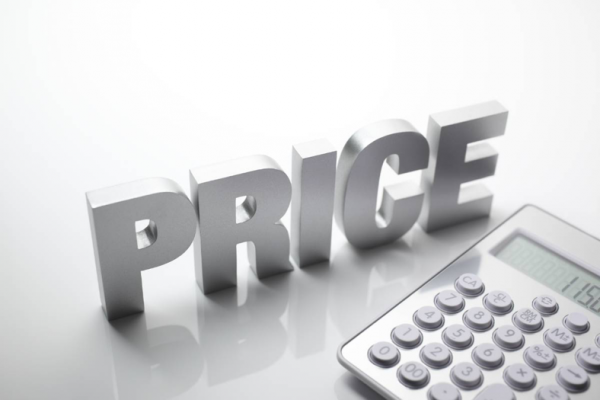
With the development of IT in the fashion business, an increasing number of brands have moved from the existing B2B market to the B2C market with their own e-commerce deployment. However, as the B2C market increases in volume, the distribution channels such as the retailing channel or branch sales begin to coexist with the B2B market. The company, especially of a small or medium size, must consider B2B and B2C from the beginning as it is the main hurdle in overcoming regional limitations and raise brand recognition.
- Prior to pricing
Depending on the strategy, pricing can be both cheap and expensive. In order to consider B2B partners and B2C end-customers, a company must contemplate the following 5 points.

A. Production price and cost of labor
First, it is most important to estimate for production costs. New brands or designer brands have a relatively higher cost since the production quantity per product is limited. Many brands are concerned about whether to produce products in Korea or overseas. There are both advantages and disadvantages to producing overseas. Producing products in countries such as China and India can reduce production costs; however, it takes more time and can lead to miscommunication during the production process. In addition, many countries including Europe require fair trade and International Labour Organization (ILO) standards. Tariffs and shipping in foreign countries can cause an increase in production costs as can be seen by the higher tariffs recently imposed on Chinese goods to the US. The cost of producing clothes can be reduced up to 6% in India with Comprehensive Economic Partnership Agreement (CEPA).
On the other hand, while production costs are relatively higher in Korea, there are advantages in terms of faster lead production periods, output, better quality, and communication. It is possible to begin basic pricing based on the minimum quantity produced by domestic or international manufacturing plants with samples. In the case of producing overseas, check the tariffs and shipping costs to determine the landed cost.
B. Determination of whether to use B2B or B2C or to use both B2B and B2C
Most Korean brands are selling on a consignment basis rather than a B2B sales structure. This causes brands to price only for the short-term, which limits sales channels and profit structure as the brand grows. Generally speaking, a B2B Company with large volume, prices the wholesale prices at 1.5 to 2 times and 2 to 2.5 times the recommended retail price (RRP) in order to gain profit.
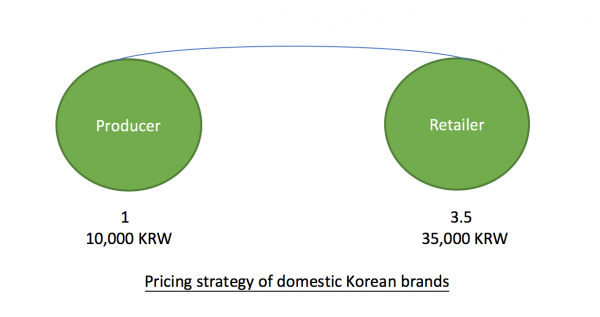
In the case of B2C, most Korean brands only consider the domestic market and set the retail price to 2 to 3 times of the production cost. This seems to work out well in the short run when sales are going well. However, the increase in the number of consignment sales, employee and promotions do not ensure internal stability. The recommended pricing is to set wholesale and retail prices at the same time when starting the brand. The following chart is an example of pricing:
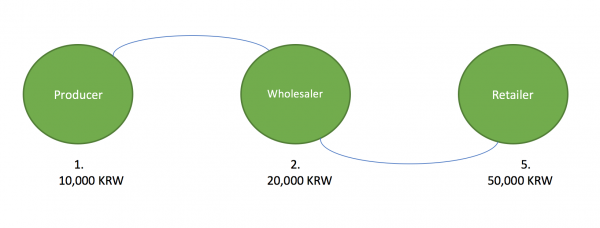
The following is a pricing structure with a basic markup to enhance sales promotion and branding:
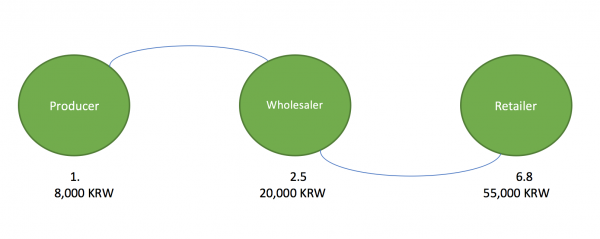
Production volume increases as sales grow, which leads to a reduction in production cost (10,000 KRW to 8,000 KRW). Existing buyers continue to purchase items at the original price of 20,000 KRW despite growing popularity, raising the cost of a new item by 10 % with a similar production cost as the previous season. As a result, the brand gains more profit by pricing at 2 to 2.5 times of the production cost. It also enables retailers to do business at a better price which enhances the brand image. (* Wholesale-RRP is 2 times in America and 2.5 times in Europe. The standard of multiple in America is landed cost while it is the before shipping price in Europe. In Korea, the pricing is usually 30 to 40% of RRP based on consignment sales rather than wholesale).
As RRP increases, B2C e-commerce, as well as the retailers, can create larger profit profit margins by pricing the product at 55,000 KRW while the production cost remains at 8,000 KRW.
Case Study – Daniel Wellington
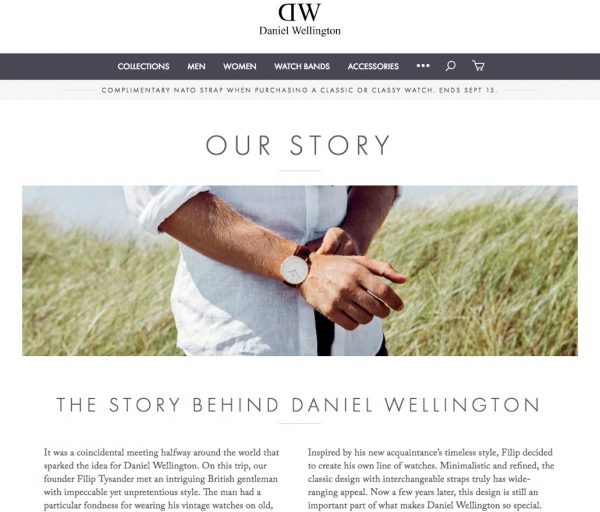
Daniel Wellington is famous for Preppy Fashion Quartz Watch Company that sold one million units and earned 70 billion KRW in 2014, and 200 billion KRW around the world in 2015. The brand had a groundbreaking marketing strategy and an aggressive sales promotion on social media. The product was priced at around 100 to 200 Euros per unit, which cost less than 10 dollars to produce in China. (Source)
This brand also set the price with some spare pricing structure from the beginning. As sales increased worldwide, the price gap increased and the profit margin increased. Daniel Wellington was successful in viral marketing through social media, especially on Instagram, where he held promotions for the companies’ followers. In addition, the minimalistic design and the preppy style were unique to the market. Popularity also increased due to affordable pricing, as the more expensive Swiss watches were in lower demand as a result of the European economic crisis.
C. Investigation of prices of competitors
After deciding the production price, and B2B, B2C or B2B2C, study similar brands on an item basis. Consider each brand size and the ratio of mixed fabric as similar as possible when selecting items. In addition, analyze the manufacturing country and compare it with the price range to help with benchmarking.
D. Investigation on tariffs and postage of exporting countries
After going through the previous steps, companies that are manufacturing products overseas need to set up a warehouse in the manufacturing country to associate with logistic distribution in order to figure out whether to utilize drop shipping or import items to Korea prior to shipping abroad. In this case, drop shipping may be advantageous when the overseas and domestic sales are around 70 and 30%.
Setting up a warehouse in Korea may be advantageous if overseas and domestic sales are around 50 percent each. In particular, it would be a big difference if the country does not have any benefits from the FTA. If the manufacturer is in Korea, find out an approximate FTA benefit for overseas shipping in Korea and postage in the United States and each Europe among TNT, UPS, etc for the better price.
When the product arrives in Europe or the U.S., tariff and shipping cost is included which makes the price competitiveness pointless. This could cause a problem in sales and brand loyalty. It would be advantageous if less than 7 percent of an order goes overseas, but currently 8 percent to 11 percent is the average. If it is over 11%, figure out ways to save on costs in order to attain effective pricing.
E. Branding
All of the marketing costs for branding must be included to a certain extent so that it can grow into a vibrant, flexible brand for a long period of time. It is common to set a budget of about 10 percent. The latest social media marketing in fashion brands can be seen below.
Items that can be produced with 10,000 KRW.
For example, when the manufacturing cost, wholesale price, or the retail price is set at a 1:2:2.5 ratios, sales through wholesale and retail price are estimated to be 10,000,000 won, where 1,000,000 won is used for marketing expenses. Therefore, it is effective to collaborate with famous bloggers and Instagram users to sell items at the price of 50,000 won compared to the production cost of 10,000 won.
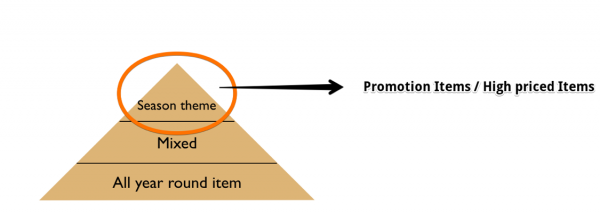
When preparing for the new season, create more fancy and trendy items rather than ordinary products for promotion in order to price it higher for effective marketing through social marketing and using celebrities to increase the brand value. A brand that gains popularity through one item can increase sales with different items in the future since the brand name is already recognized in the market.
2. Pricing
As I mentioned earlier, there can not be a correct formula for pricing. However, speaking from experience, the following section is the pricing guide analyzation of domestic and overseas brands that focus on domestic market accordingly to the pricing structure.
Case Study
In early June, the CEO of a Korean company who was interested in Harsest Report sent an email asking questions regarding collaboration. One of the questions was about pricing.
“Our company only held sales in Korea through a website and on consignment so far. Would it be beneficial to differentiate the price range in Korea with overseas pricing?”
In order to answer the question, we signed a non-disclosure agreement since it dealt with some of the company’s confidential information. The company did not have any wholesales, was manufacturing in Korea and had a couple of overseas orders with ten million won in revenue.
The company’s pricing structure in the domestic market is as follows:
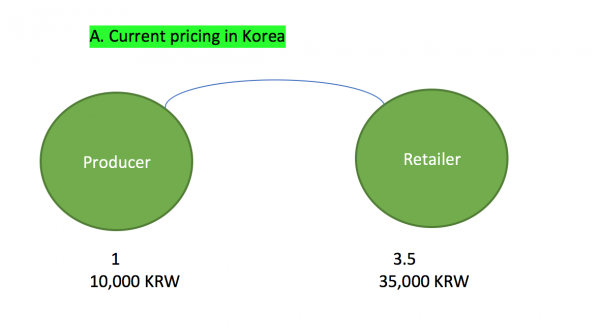
The following is the profit margin structure if the company starts overseas sales with retailer standards in Germany with the pricing structure of Korea as an example. The wholesale and retail price for 2.5 multiple pricing is as follows:
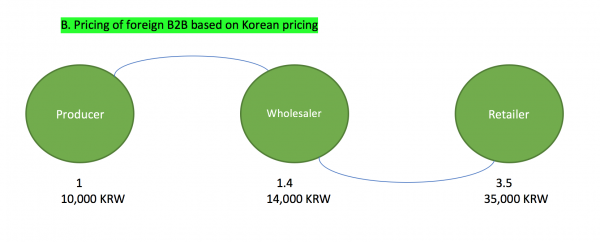
When selling a T-shirt to a retailer overseas, 4,000 won or 1.4 multiples is not good enough to do business unless selling at larger volumes. Without a suitable payment term and logistics set up, profit margin volume would be much less.
The current price range in Korea makes it difficult to start a business abroad. The core of the proposed measures was the sequential rise in prices and changes in profit margin structure in domestic and overseas price.
Foreign markets will receive the product in January or February of the following year if the season pre-orders are placed in July. In Korea, with the pre-order production of overseas sales, it is possible to combine with domestic production to increase volume and reduce manufacturing cost. Therefore, with a 20% reduced cost compared to Korean pricing standard (10,000 won: X: 35,000 won), 10% of the price can be increased in the first season. It is now possible to maintain pricing # 1.
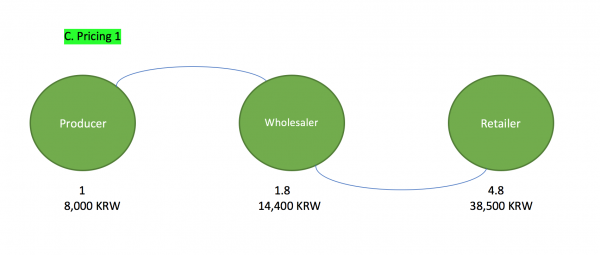
When Korean prices are formed, the multiples of wholesale prices in overseas pricing can be formed as follows.
The overseas price multiples were changed to 1:1.8:4.8 under the condition of giving the retailer 2.5 multiples, which is a double price profit margin of previous domestic seasonal price in retail sales. Considering the case, the RRP is 5 times higher by increasing 10% of the domestic price. The new pricing structure is shown below.
It becomes similar to the general pricing structure of 1:2:2.5, creating a price zone where the pricing structure can be used for overseas B2B in the domestic market.
However, it is better for expensive brand items to gradually expand multiples by 5%, and start retail sales overseas with the domestic market as the primary sales target until the price reaches general pricing structure. It can be used to increase brand value with promotions. In addition, increasing price must be followed after ensuring gentrification and recognition of the brand in order to avoid losing loyal customers.
Closing sentences:
Pricing is a channel that represents brand value, and the last step is to value the items shown in the collection. There should be an appropriate price point as the last stage before going into sales.
The price is difficult to change later on. Expensive and inexpensive products are neither good nor bad. Pricing is of utmost importance for long-term preparation and the initial growth of the brand. Setting up the wholesale price helps future growth and expansion. Remember the 1:2:5 or 1:2.5:6.25 multiples and follow it according to the brand strategy for stable growth and successful sales.
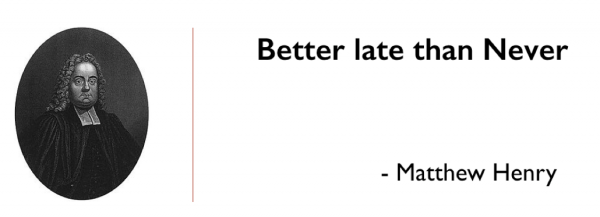


No Comments